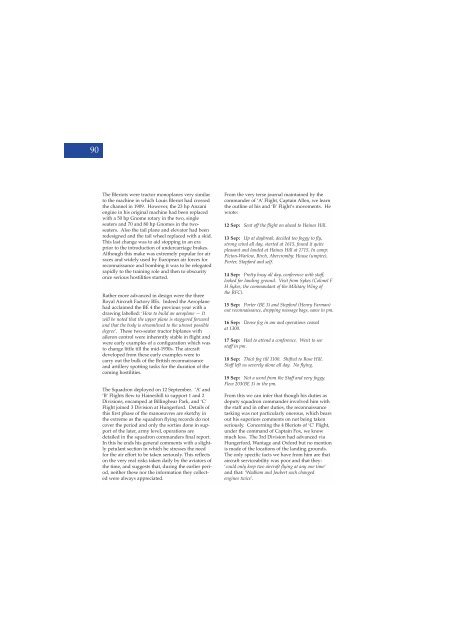Volume 6 No 4 - Royal Air Force Centre for Air Power Studies
Volume 6 No 4 - Royal Air Force Centre for Air Power Studies
Volume 6 No 4 - Royal Air Force Centre for Air Power Studies
You also want an ePaper? Increase the reach of your titles
YUMPU automatically turns print PDFs into web optimized ePapers that Google loves.
90<br />
The Bleriots were tractor monoplanes very similar<br />
to the machine in which Louis Bleriot had crossed<br />
the channel in 1909. However, the 23 hp Anzani<br />
engine in his original machine had been replaced<br />
with a 50 hp Gnome rotary in the two, single<br />
seaters and 70 and 80 hp Gnomes in the twoseaters.<br />
Also the tail plane and elevator had been<br />
redesigned and the tail wheel replaced with a skid.<br />
This last change was to aid stopping in an era<br />
prior to the introduction of undercarriage brakes.<br />
Although this make was extremely popular <strong>for</strong> air<br />
races and widely used by European air <strong>for</strong>ces <strong>for</strong><br />
reconnaissance and bombing it was to be relegated<br />
rapidly to the training role and then to obscurity<br />
once serious hostilities started.<br />
Rather more advanced in design were the three<br />
<strong>Royal</strong> <strong>Air</strong>craft Factory BEs. Indeed the Aeroplane<br />
had acclaimed the BE 4 the previous year with a<br />
drawing labelled: ‘How to build an aeroplane — It<br />
will be noted that the upper plane is staggered <strong>for</strong>ward<br />
and that the body is streamlined to the utmost possible<br />
degree’. These two-seater tractor biplanes with<br />
aileron control were inherently stable in flight and<br />
were early examples of a configuration which was<br />
to change little till the mid-1930s. The aircraft<br />
developed from these early examples were to<br />
carry out the bulk of the British reconnaissance<br />
and artillery spotting tasks <strong>for</strong> the duration of the<br />
coming hostilities.<br />
The Squadron deployed on 12 September. ‘A’ and<br />
‘B’ Flights flew to Haineshill to support 1 and 2<br />
Divisions, encamped at Billingbear Park, and ‘C’<br />
Flight joined 3 Division at Hunger<strong>for</strong>d. Details of<br />
this first phase of the manoeuvres are sketchy in<br />
the extreme as the squadron flying records do not<br />
cover the period and only the sorties done in support<br />
of the later, army level, operations are<br />
detailed in the squadron commanders final report.<br />
In this he ends his general comments with a slightly<br />
petulant section in which he stresses the need<br />
<strong>for</strong> the air ef<strong>for</strong>t to be taken seriously. This reflects<br />
on the very real risks taken daily by the aviators of<br />
the time, and suggests that, during the earlier period,<br />
neither these nor the in<strong>for</strong>mation they collected<br />
were always appreciated.<br />
From the very terse journal maintained by the<br />
commander of ‘A’ Flight, Captain Allen, we learn<br />
the outline of his and ‘B’ Flight’s movements. He<br />
wrote:<br />
12 Sep: Sent off the flight on ahead to Haines Hill.<br />
13 Sep: Up at daybreak, decided too foggy to fly,<br />
strong wind all day, started at 1615, found it quite<br />
pleasant and landed at Haines Hill at 1715. In camp:<br />
Picton-Warlow, Birch, Abercromby: House (umpire),<br />
Porter, Stop<strong>for</strong>d and self.<br />
14 Sep: Pretty busy all day, conference with staff,<br />
looked <strong>for</strong> landing ground. Visit from Sykes (Colonel F<br />
H Sykes, the commandant of the Military Wing of<br />
the RFC).<br />
15 Sep: Porter (BE 3) and Stop<strong>for</strong>d (Henry Farman)<br />
out reconnaissance, dropping message bags, same in pm.<br />
16 Sep: Dense fog in am and operations ceased<br />
at 1300.<br />
17 Sep: Had to attend a conference. Went to see<br />
staff in pm.<br />
18 Sep: Thick fog till 1100. Shifted to Rose Hill.<br />
Staff left us severely alone all day. <strong>No</strong> flying.<br />
19 Sep: <strong>No</strong>t a word from the Staff and very foggy.<br />
Flew 203(BE 3) in the pm.<br />
From this we can infer that though his duties as<br />
deputy squadron commander involved him with<br />
the staff and in other duties, the reconnaissance<br />
tasking was not particularly onerous, which bears<br />
out his superiors comments on not being taken<br />
seriously. Concerning the 4 Bleriots of ‘C’ Flight,<br />
under the command of Captain Fox, we know<br />
much less. The 3rd Division had advanced via<br />
Hunger<strong>for</strong>d, Wantage and Ox<strong>for</strong>d but no mention<br />
is made of the locations of the landing grounds.<br />
The only specific facts we have from him are that<br />
aircraft serviceability was poor and that they:<br />
‘could only keep two aircraft flying at any one time’<br />
and that: ‘Wadham and Joubert each changed<br />
engines twice’.
















